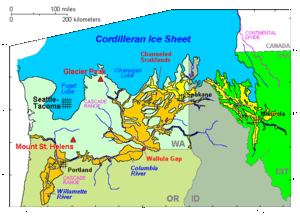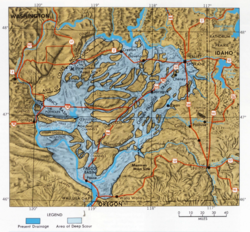Channeled Scablands
This article includes a list of generalreferences,butit lacks sufficient correspondinginline citations.(February 2023) |

TheChanneled Scablandsare a relatively barren and soil-free region of interconnected relict and dry flood channels,couleesandcataractseroded into Palouseloessand the typically flat-lying basalt flows that remain after cataclysmic floods within the southeastern part ofWashington state.[1][2]The Channeled Scablands were scoured bymore than 40 cataclysmic floodsduring theLast Glacial Maximumand innumerable older cataclysmic floods over the last two million years.[3][4][5]These floods were periodically unleashed whenevera large glacial lakebroke through its ice dam and swept across eastern Washington and down theColumbia River Plateauduring thePleistoceneepoch.The last of the cataclysmic floods occurred between 18,200 and 14,000 years ago.[6]
GeologistJ Harlen Bretzdefined "scablands" in a series of papers written in the 1920s as lowlands diversified by a multiplicity of irregular channels and rock basins eroded into basalt. Flood waters eroded the loess cover, creating largeanastomizing channelsthat exposed bare basalt and creatingbutte-and-basintopography. The buttes range in height from 30 to 100 m (98 to 328 ft), while the rock basins range from 10 m (33 ft) in width up to the 11 km (7 mi) long and 30 m deepRock Lake.Bretz further stated, "The channels run uphill and downhill, they unite and they divide, they head on the back-slopes and cut through the summit; they could not be more erratically and impossibly designed."[7]
The debate on the origin of the Scablands that ensued for four decades became one of the great controversies in the history ofearth science.The Scablands are also important to planetary scientists as perhaps the best terrestrial analog of the Martianoutflow channels.[8][page needed]
History
[edit]
Bretz conducted research and published many papers during the 1920s describing the Channeled Scablands. His theories of how they were formed requiredshort but immense floods– 500 cubic miles (2,100 km3) – for which Bretz had no explanation. His theories of apparentcatastrophismmet with vehement opposition from geologists of the day, who tried to explain the features withuniformitariantheories – that they were shaped by processes still acting today.
J. T. Pardeefirst suggested in 1925 to Bretz that the draining of aglacial lakecould account for flows of the magnitude needed. Pardee continued his research over the next 30 years, collecting and analyzing evidence that eventually identifiedLake Missoulaas the source of the floods (now theMissoula floods) and creator of the Channeled Scablands.
Pardee's and Bretz's theories were accepted only after decades of painstaking work and fierce scientific debate. Research on open-channel hydraulics in the 1970s put Bretz's theories on solid scientific ground. In 1979 Bretz received the highest medal of theGeological Society of America,thePenrose Medal,to recognize that he had developed one of the great ideas in the earth sciences.
Geology
[edit]Distinctgeomorphological featuresinclude coulees, dry falls, streamlined hills and islands of remnant loess, gravel fans andbars,andgiant current ripples.[7]
The term scabland refers to an area that has experienced fluvial erosion resulting in the loss of loess and other soils, leaving the land barren.[9]River valleysformed by erosional downcutting of rivers create V-shaped valleys, whileglacierscarve outU-shaped valleys.The Channeled Scablands have a rectangular cross section, with flat plateaus and steep canyon sides, and are spread over immense areas ofeastern Washington.The morphology of the scablands is butte-and-basin.[9]The area that encompasses the Scablands has been estimated between 1,500 and 2,000 square miles (3,900 and 5,200 km2), though those estimates still may be too conservative.[10]
They exhibit a uniquedrainagepattern that appears to have an entrance in the northeast and an exit in the southwest. TheCordilleran ice sheetdammed up Glacial Lake Missoula at the Purcell Trench Lobe.[10]A series of floods occurring over the period of 18,000 to 13,000 years ago swept over the landscape when the ice dam broke. The eroded channels also show ananastomosing,or braided, appearance.
The presence ofMiddleandEarly PleistoceneMissoula flood deposits have been documented within the Channeled Scabland as other parts of the Columbia Basin, e.g. the Othello Channels, Columbia River Gorge, Quincy Basin, Pasco Basin, and theWalla Walla Valley.Based on the presence of multipleinterglacialcalcretesinterbedded withglaciofluvial flood deposits,magnetostratigraphy,optically stimulated luminescencedating, andunconformitytruncatedclastic dikes,it has been estimated that the oldest of these megafloods flowed through the Channel Scablands sometime before 1.5 million years ago. Because of the fragmentary nature of older glaciofluvial deposits, which have been largely removed by subsequent Missoula floods, the exact number of older Missoula floods, which are known asAncient Cataclysmic Floods,that occurred during the Pleistocene cannot be estimated with any confidence.[3][4]As many as 100 separate, cataclysmic Ice Age floods may have occurred during the last glaciation.[11]There have been at least 17 complete interglacial-glacial cycles since about 1.77 million years ago, and perhaps as many as 44 interglacial-glacial cycles since the beginning of the Pleistocene about 2.58 million years ago. Presuming a dozen (or more) floods were associated with each glaciation, the total number of cataclysmic Ice Age Missoula floods that flowed through the Channeled Scablands for the entire Pleistocene Epoch could possibly number in the hundreds, perhaps exceeding a thousand Ancient Cataclysmic Floods.[5]
There are also immensepotholesandripple marks,much larger than those found on ordinary rivers. When these features were first studied, no known theories could explain their origin. Thegiant current ripplesare between 3 and 49 feet (1 and 15 m) high and are regularly spaced, relatively uniform hills.[9]Vast volumes of flowing water would be required to produce ripple marks of this magnitude, as they are larger-scale versions of the ripple marks found on streambeds that are typically only centimeters high. Large potholes were formed by swirling vortexes of water calledkolksscouring and plucking out the bedrock.[10]
The Scablands are littered with large boulders calledglacial erraticsthat rafted on glaciers and were deposited by the glacial outburst flooding. The lithology of erratics usually does not match the rock type that surrounds it, as they are often carried very far from their origin.[10]
See also
[edit]- Wallula Gap– Large water gap of the Columbia River through basalt anticlines in the U.S. state of Washington
- Grand Coulee– Ancient river bed in the U.S. state of Washington
- Moses Coulee– Canyon in the Waterville plateau region of Douglas County, Washington
- Lake Lenore (Washington)– Lake formed by the Missoula Floods in the lower Coulee in Washington state
- Glacial lake outburst flood– Type of outburst flood that occurs when the dam containing a glacial lake fails
- Drumheller Channels National Natural Landmark– U.S. natural landmark in Washington state
- Dry Falls– Scalloped precipice with four major alcoves, in central Washington scablands
- Giant current ripples– Depositional forms in channeled scablands
- Diluvium– Deposits created as a result of catastrophic outbursts of Pleistocene giant glacier-dammed lakes
- Outflow channels– Long, wide swathes of scoured ground on Mars
- Altai flood– Prehistoric event in Central Asia
- Turnbull National Wildlife Refuge
- Touchet Formation– Geological formation in Washington, US
- Lake Lewis– lake in United States of America
Notes
[edit]- ^Bjornstad, B.; Kiver, E. (2012).On the Trail of the Ice Age Floods: The Northern Reaches: A geological field guide to northern Idaho and the Channeled Scabland.Sandpoint, Idaho: Keokee Books.ISBN978-1879628397.
- ^Neuendorf, K.K.E., J.P. Mehl, Jr., and J.A. Jackson, eds. (2005)Glossary of Geology(5th ed.). Alexandria, Virginia, American Geological Institute. 779 pp.ISBN0-922152-76-4
- ^abMedley, E. (2012).Ancient Cataclysmic Floods in the Pacific Northwest: Ancestors to the Missoula Floods(Thesis). Portland, Oregon: Unpublished Masters thesis, Portland State University.
- ^abSpencer, P. K.; Jaffee, M. A. (2002). "Pre-Late Wisconsinan Glacial Outburst Floods in Southeastern Washington—The Indirect Record".Washington Geology.30(1/2): 9–16.
- ^abBjornstad, B. (2002).Standardized Stratigraphic Nomenclature for Post-Ringold-Formation Sediments Within the Central Pasco Basin.Report DOE/RL-2002-39 Rev. 0. Richland, Washington: Pacific Northwest National Laboratory, US Department of Energy.
- ^Balbas, A.M., Barth, A.M., Clark, P.U., Clark, J., Caffee, M., O'Connor, J., Baker, V.R., Konrad, K. and Bjornstad, B., 2017.10Be dating of late Pleistocene megafloods and Cordilleran Ice Sheet retreat in the northwestern United States.Geology,45(7), pp. 583-586.
- ^abBaker, Victor (2010). Migoń, Piotr (ed.).Channeled Scablands: A Megaflood Landscape, in Geomorphological Landscapes of the World.Springer. pp. 21–28.ISBN9789048130542.
- ^Carr, M. H. (2006),The Surface of Mars.Cambridge Planetary Science Series, Cambridge University Press.
- ^abcBaker, Victor R. (30 December 2008).The Channeled Scabland: A Retrospective(PDF).Reviews in Advance. Annual Reviews. Archived fromthe original(PDF)on 2017-08-12.Retrieved9 October2013.
- ^abcdFoster, Tom."Channeled Scabland".HugeFloods.com.Retrieved9 October2013.
- ^Waitt, RB, Jr. (1994)Scores of Gigantic, Successively Smaller Lake Missoula Floods Through Channeled Scabland and Columbia Valley,inGeologic Field Trips in the Pacific Northwest: 1994 Geological Society of America Meeting,Chapter 1K, D. A. Swanson and R. A. Haugerud (eds.), Geological Society of America, Boulder, Colorado.
Additional references
[edit]- Allen, John Eliot;Burns, Marjorie;Sargent, Sam C. (1986).Cataclysms on the Columbia.Portland, Oregon: Timber Press.ISBN0-88192-215-3.
- Bretz, J Harlen (1923). "The Channeled Scabland of the Columbia Plateau".Journal of Geology.31(8): 617–649.Bibcode:1923JG.....31..617B.doi:10.1086/623053.
- Bretz, J Harlen (1925). "The Spokane flood beyond the Channeled Scablands".Journal of Geology.33(2): 97–115, 236–259.Bibcode:1925JG.....33...97B.doi:10.1086/623179.
- Bretz, J.; Smith, H. T.; Neff, G. E. (1956). "Channeled Scabland of Washington: New Data and Interpretations".Geological Society of America Bulletin.67(8): 957–1049.doi:10.1130/0016-7606(1956)67[957:CSOWND]2.0.CO;2.
- Soennichsen, John (2008).Bretz's Flood: The Remarkable Story of a Rebel Geologist and the World's Greatest Flood.Seattle, Washington: Sasquatch Books.ISBN978-1-57061-505-4.
External links
[edit]- Bjornstad, Bruce;Ice Age Floodscapes YouTube Channel
- "Channeled Scablands Theory".Archived from the original on 12 February 2006.
{{cite web}}:CS1 maint: unfit URL (link)
- United States Geological SurveyThe Channeled Scablands of Eastern WashingtonFive chapters with 23 illustrations and maps.
- Steven Dutch, University of Wisconsin - Green Bay,Channeled Scablands: Overview
- Historical Discussion
- PBS'sNOVA:Mystery of the Megaflood
- Scablands in Google Maps
- Online bookfrom theNational Park Serviceabout the geologic origins of the scablands.
- Sun Lakes-Dry Falls State Parkin the Channeled Scablands
- Columbia Plateau Trail StateParkin the Channeled Scablands
- The Seattle Times'Pacific NWmagazine- "Trailing an Apocalypse" - 30-Sep-2007
- Keenan Lee.Altai Flood
- Rojas-Burke, Joe (2010-02-20)."Geologists find a way to simulate the great Missoula floods".The Oregonian.




